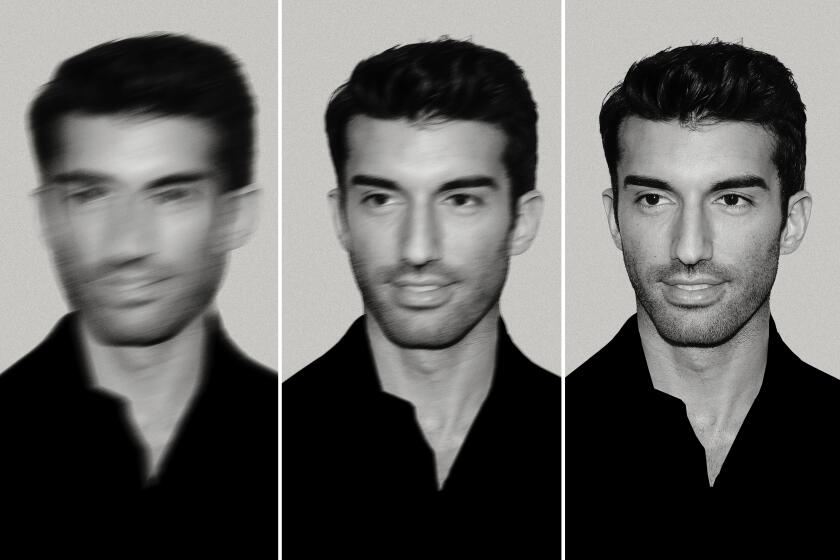Seeing the Big Picture in 3-D
- Share via
Stephen Low tried to avoid becoming a filmmaker, having spent “too many hours around film sets” as a youth, when his father was making notable documentaries in the early 1950s.
A self-described “outdoors guy,” the 47-year-old Canadian director--his Imax 3-D movie “Mark Twain’s America” opens today (review, Page 18)--recalls that he “fell into filmmaking” through the peculiar circumstance of working as a scuba diver in Newfoundland.
“I [got] hired onto ‘Orca,’ ” he said, referring to a 1977 Richard Harris action movie about a killer whale that bites off Bo Derek’s leg. “They needed scuba divers. Then they needed drivers more than they needed divers. So I drove Bo Derek around for the rest of the picture.”
That movie, “a real mess,” Low adds, led to other production jobs--film loader, camera technician--until he finally decided, “The heck with this. I want to make my own films.”
Like his father, Colin Low, who made “Universe” (a special-effects film that influenced Stanley Kubrick’s “2001”) and later the first Imax 3-D movie, “Transitions,” the son turned to the 3-D Imax format because it was a new cinematic language.
“I think 3-D is a much better narrative medium than 2-D,” Low said in a recent interview at the Irvine Spectrum. “3-D gives a sensible scale to everything [in the frame] so that it’s more natural.”
With Greg MacGillivray, George Casey, Graham Ferguson and a few others, Low is one of the more prolific filmmakers working in Imax. Low has made five Imax films in 2-D, among them “Beavers,” “The Last of the Buffalo” and “Titanica,” and three in 3-D, including “Across the Sea of Time.”
The idea for “Mark Twain’s America” goes back to 1993, when Low was researching “Across the Sea of Time” at the California Museum of Photography at Riverside and found, along with the 19th century stereo-optic photos used in that movie, archival pictures of Twain as well.
“We discovered original 3-D shots of him that had never been seen,” Low said. “I don’t think we would have embarked on this project if we hadn’t had wonderful 3-D stuff on him to start with.”
Three-dimensional stills--or stereo-optic photos--were common as early as the 1850s. People subscribed to 3-D card collections. “They would look at these cards through stereopticons, some very elaborate ones, which they had in their living rooms,” Low said. “It was a kind of precursor to cinema.”
When motion pictures came along, movement took precedence over 3-D effects. However, when it proved too difficult technically to combine 3-D and motion, 3-D essentially disappeared.
Even today, with the successful introduction of the Imax format, the limitations of filming in 3-D are still so considerable that we’re not likely to see any full-length 3-D Imax feature films any time soon.
“Drama is not on the horizon,” Low said. “I wish it were. I’d love to make Hollywood features [in this format]. But the economics are not there, and the art of the cinema is totally economics. It drives the whole thing.”
One reason for the problem is the high cost of Imax production. “Mark Twain’s America,” a 40-minute documentary that includes only short sequences of live-action footage, cost $6 million to make over 14 months.
“It could easily have cost $20 million,” Low said. “This format is much more expensive than the basic standard 35 millimeter.”
And more cumbersome.
3-D Imax cameras--of which there are only three in the world, Low says--weigh roughly 250 pounds. That compares with 30 pounds for a 35-mm camera. Imax film stock is 20 times larger than the 35-mm negative. Because of that, the sprocket rate of the film must be faster to achieve the motion-picture standard of 24 frames per second.
As a result, the Imax camera runs at very high speed and can only hold three minutes of film at a time; plus it takes 20 minutes to reload. (Standard 35-mm cameras hold 10 minutes of film and take a few seconds to reload.)
Shooting in 3-D is like using “two 70-mm films, pulled sideways through the camera,” Low said. “It’s six times bigger than the 70-mm film used for ‘Lawrence of Arabia.’ You want big format? You gotta pay.”
If feature-length dramas are not on the horizon for Imax moviegoers, then what is?
“Documentaries--maybe,” Low said. “They cost less. But at the moment, we’re not getting much of the box office. It’s a complicated problem, and it’s frustrating.”
More to Read
Only good movies
Get the Indie Focus newsletter, Mark Olsen's weekly guide to the world of cinema.
You may occasionally receive promotional content from the Los Angeles Times.










